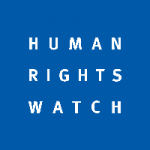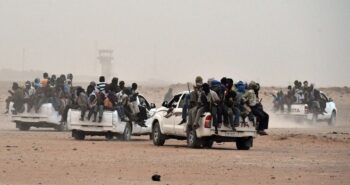Hundreds in Tarhouna Reported Missing From 2014 to 2020
 Hundreds of residents of the Libyan town Tarhouna were abducted or reported missing between 2014 and 2020, Human Rights Watch said today.
Hundreds of residents of the Libyan town Tarhouna were abducted or reported missing between 2014 and 2020, Human Rights Watch said today.
Authorities of the country’s Government of National Accord (GNA) say that they have discovered 27 mass graves in Tarhouna since June, but that they have yet to identify the bodies.
At least 338 residents of Tarhouna were reported missing after the local al-Kani militia, known as Kaniyat, took control of the town in 2015, the GNA-linked Public Authority for Search and Identification of Missing Persons said.
Residents reported that the militia often abducted, detained, tortured, killed, and disappeared people who opposed them or who were suspected of doing so. Some said the militia seized private property and stole their money.
The GNA authorities should investigate what happened to the missing residents. Foreign governments and the United Nations should provide forensics experts and conduct DNA testing to help with the GNA’s gravesite investigations.
“Families in Tarhouna whose loved ones went missing face a difficult time moving forward with their lives,” said Hanan Salah, senior Libya researcher at Human Rights Watch. “The authorities should act on the grim discovery of mass graves by taking proper steps to identify the bodies and bringing those responsible for abuses to justice.”
In November and December, Human Rights Watch spoke with members of eight families who alleged that al-Kaniyat militia was responsible for the disappearance of one or more of their relatives between September 2019 and April 2020. Human Rights Watch also spoke with journalists, local activists, GNA authorities, and members of nongovernmental organizations.
The Association of Families of the Missing, a civil society group that’s assisting families of the missing people from Tarhouna, provided Human Rights Watch with data on 166 Tarhouna residents whom the al-Kani militia allegedly abducted or disappeared.
The al-Kaniyat militia controlled every aspect of life in Tarhouna from 2015 until June 2020, when GNA forces drove it out. Tarhouna, about 93 kilometers southeast of Tripoli, is a gateway to Libya’s center and east.
When General Khalifa Hiftar, commander of the eastern-based Libyan Arab Armed Forces (LAAF) and the GNA’s main rival, attacked Tripoli in April 2019, the al-Kaniyat militia withdrew its allegiance to the GNA, joined forces with Hiftar, and adopted the name 9th Brigade.
The militia was a family endeavor. Mohammed Khalifa al-Kani, widely regarded as the group’s leader, was joined by four of his brothers – Abdelkhaleq, Muammar (Omar), Abdulrahim, and Muhsen. Muhsen was killed in September 2019.
All interviewees alleged that the al-Kaniyat militia was responsible for the disappearance of their relatives. Members of six of the eight families alleged that Mohamed and Abdulrahim al-Kani were directly implicated in the disappearance of their relative.
One resident of Tarhouna, three of whose relatives were abducted by the militia, said: “When they capture and kill someone, they also make sure to kill the rest of [the men in] his family so that they don’t
Dr. Kamal al-Siwi, head of the Public Authority for Search and Identification of Missing Persons, said that the vast majority of people missing in Tarhouna disappeared during the fighting that began in April 2019 and ended in June 2020.
The Authority, which keeps a database of missing people, is responsible for exhuming and identifying bodies, including Tarhouna’s grave sites.
Al-Siwi said that since June, the Authority has exhumed about 120 bodies, including some women and children, from unmarked grave sites in and around Tarhouna. Each exhumed grave site held between 1 and 12 bodies, and in some cases body parts.
While most are located in a large agricultural area known as Mashrou’ al-Rabt, two bodies were found in Tarhouna in water wells and another was found in a location belonging to the Interior Ministry. He said some bodies were found handcuffed and most were in an advanced state of decay, which prevented relatives from identifying them.
One body had an emergency ventilator attached. The Authority takes DNA samples from every exhumated body, and from relatives of people reported missing. Al-Siwi said the missing persons authority has not yet identified any of the bodies, but that the General Prosecutor’s Office identified three exhumed bodies and allowed the families to bury them.
A relative of Ali Mohamed Ramadan al-Touhami, who had been missing since December 2019, told Human Rights Watch that the authorities exhumed his body from a mass grave in Tarhouna on November 18, 2020, and transferred him to a hospital in Tripoli, where family members identified him through his clothes, teeth, and an old bullet wound unrelated to the conflict. His body will be released for burial during January 2021.
Al-Siwi also said that the main reason behind the delay in identification of exhumed bodies was the lack of sufficient budget to purchase necessary items to operate the Authority’s existing laboratory for DNA analysis and that some staff needed additional training.
All family members who spoke with Human Rights Watch said that their relatives were not fighters. They said that the al-Kaniyat militia targeted them because they opposed the militia or because their family had supported the 2011 revolution that resulted in the killing of Libya’s longtime dictator, Muammar Gaddafi.
The al-Kani brothers and many others in Tarhouna had not opposed Gaddafi. Other residents said their relatives were targeted because they had financial means.
Family members said that locations the al-Kaniyat militia used as interrogation and detention facilities in Tarhouna included Ain al-Rumiya, a former bottled water factory, a Judicial Police facility known as Qadhai’ya, and a military police facility known as Da’am.
Some cases of the missing involve enforced disappearances, which arise when government authorities or people acting as their agents detain or abduct people and then refuse to acknowledge their whereabouts or what has happened to them.
Enforced disappearances violate fundamental rights to liberty, security, and freedom from torture or cruel, inhuman and degrading treatment. Prior to the April 2019 fighting, the al-Kaniyat militia was allied with the GNA and may have acted on its behalf.
All parties to the multiple phases of the armed conflicts in Libya were bound by international humanitarian law, or the laws of war. The al-Kaniyat militia joined the military coalition that was fighting against Hiftar and his allied forces in the conflict that began in July 2014, and then allied with Hiftar’s LAAF when the April 2019 conflict started.
The laws of war prohibit torture, abductions and unlawful detention of civilians, and killings in custody, among other violations.
War crimes are serious violations of the laws of war carried out by individuals with criminal intent. Those who commit, order, assist, or have command responsibility for war crimes in Libya are subject to prosecution by domestic courts or the International Criminal Court (ICC), which has a mandate over war crimes, crimes against humanity, and genocide in Libya since February 15, 2011, under UN Security Council Resolution 1970 (2011).
Under the doctrine of command responsibility, commanders are criminally responsible for the war crimes of their subordinates if the commanders knew or should have known of the abuses and failed to prevent them or punish those responsible.
In November 2020, the ICC prosecutor reported that her office conducted two missions to Libya and that it had “received credible information indicating, that forces from Tarhouna affiliated with the LNA are alleged to have committed serious crimes including killings, abductions, [and] enforced disappearances…”
The ICC prosecutor had previously called on Libyan authorities to take steps to protect and secure the mass grave sites in Tarhouna. According to a GNA communique from December 23, 2020, ICC officials have visited Libya, including Tarhouna, where they visited sites with unmarked graves and took testimony from victims’ family members.
In November, the United States government in Executive Order 13818 designated Mohamed al-Kani and the al-Kaniyat militia for sanctions for “the murder of civilians recently discovered in numerous mass graves in Tarhouna, as well as torture, forced disappearances, and displacement of civilians.”
“Not just al-Kani leaders, but also senior LAAF commanders could be criminally liable for abuses committed by al-Kaniyat militia in Tarhouna for whom they had command responsibility,” Salah said.
_____________




